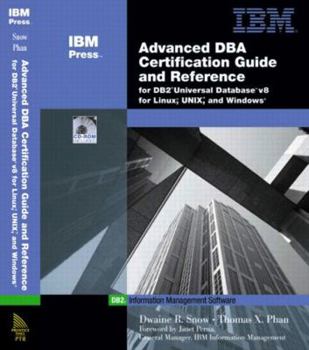Advanced DBA Certification Guide and Reference for DB2(R) Universal Database v8 for Linux, UNIX, and Windows
Select Format
Select Condition 
Book Overview
Customer Reviews
Rated 5 starsAbsolutely the best DB2 book!
I just found this book, and after reading it wish I had found this years ago. This is the most comprehensive book on DB2 that I have ever seen. This book has already saved me a lot of time. The performance chapter is great and helped me improve the performance of my DB2 server by over 30% in less than a week.
0Report
Rated 5 starsExcellent book
This is the book I was waiting for long on DB2UDB. This not only covers topics for certifications but also good (very good) reference material for all UDB DBAs on LUW platform.
0Report
Rated 5 starsbest advanced DB2 UDB DBA book out there
As an experienced DBA on Oracle and DB2 UDB, this book hands down is the best reference and support guide on the DB2 UDB environment. It cuts to the point without wasting pages explaining what DB2 UDB is. Excellent for when you need to implement complex backup and recovery or if your database crashes at 2am you will be thankful to have this critical reference. The other books for the most part on DB2 UDB are garbage and a...
0Report
Rated 5 starsBest DB2 Advanced Reference
This book goes further than all other DB2 books I've read. It is not a simple 'how to' guide, it also gives lots of good practices and info not always known by the average DBA.If you are trying to push your DB2 expertise to the next level, this is the book you should try first.
0Report
Rated 5 starsGreat Reference, Great Info
I've come to rely on this book for all my day to day DBA activities. It has the explanations, illustrations, and sample programs like the User Exit program needed to make it an invaluable reference. I recommend this book for all DBA's wanting a better understanding of how DB2 works.
0Report






















